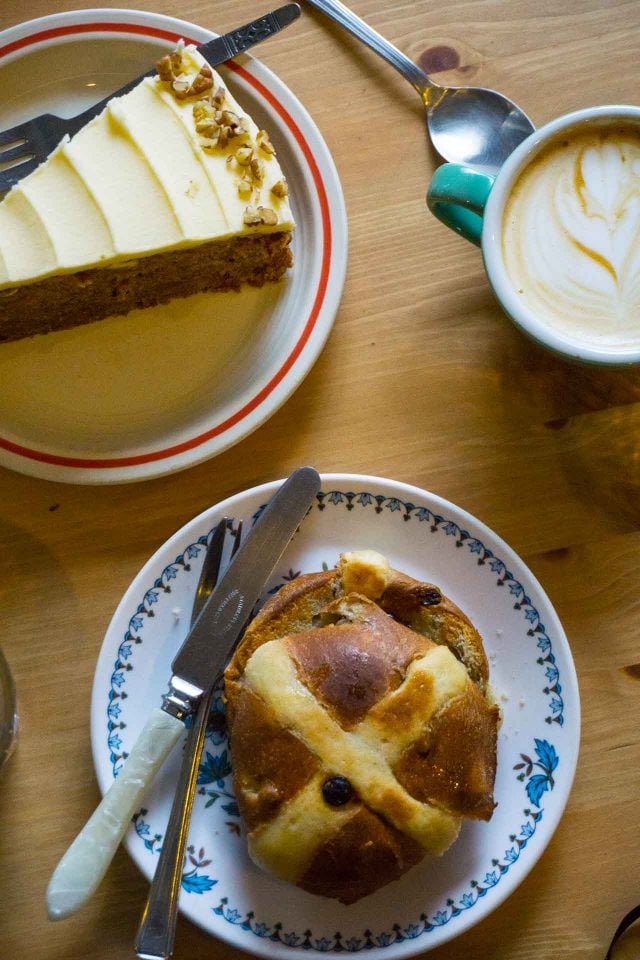
One of the many places on my bucket list of places to visit has been Scotland. In each place on that ever-growing list, there’s usually a food or drink that is associated with the place, that makes it even more compelling for me want to visit it.
Okay, who am I kidding? There are usually a number of things (invariably, edible) that make me want to visit a place. In this case, the main one was Scotch whisky, something I wanted to learn more about. Sure, you can buy a few bottles and read up on it. But I’ve learned from visiting places, such as the Jura to see how Comté cheese is made, to Normandy, to watch copper cookware being hammered out, that the best want to understand something is to see, and taste it, where it’s made.

Last fall, I was staying with my friends Paul and Lani in Philadelphia, who are about to head on a multi-year voyage around the world with their three kids. They’d done the trip twice before (and yes, joining them for a month on the boat is also on my bucket list, too), and are packing up to hit the open seas again for a few years. Over breakfast one morning in their kitchen, we started going through places we both were interested in visiting, and Edinburgh rose to the top of the list.
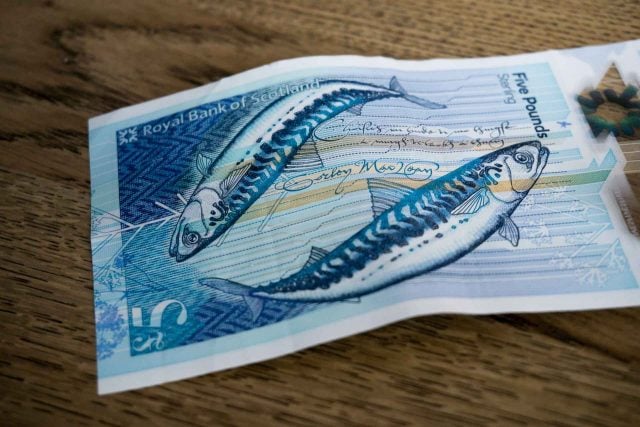
My friends own a tour company, Context Travel, and have experts on the ground in many places, including Scotland, and I was clear when we were finalizing places to go in Edinburgh, that I wanted to focus on food and drink.

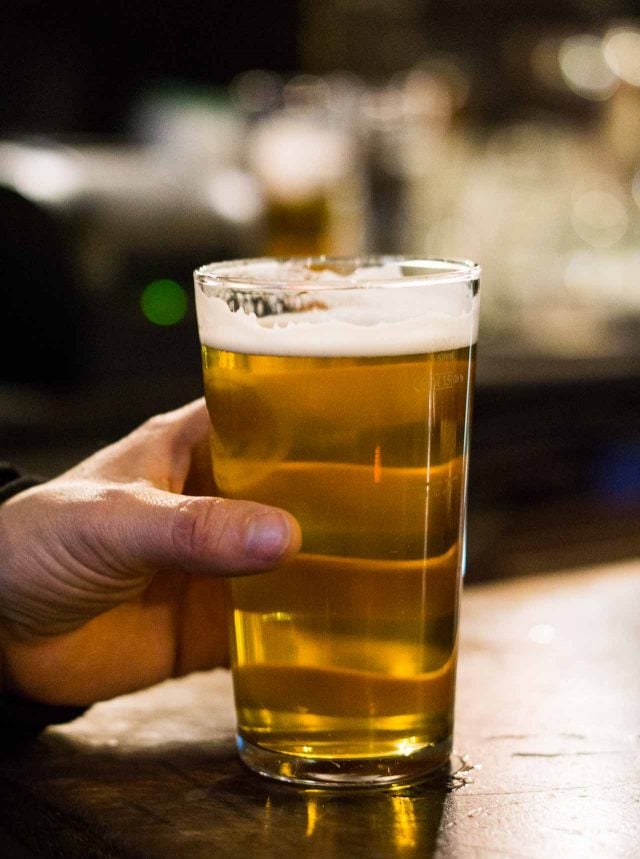
Because they had to head home to pack up their lives, Romain and I, and their family, just had a few days in Edinburgh, which we packed with meals, tours, and tastings.
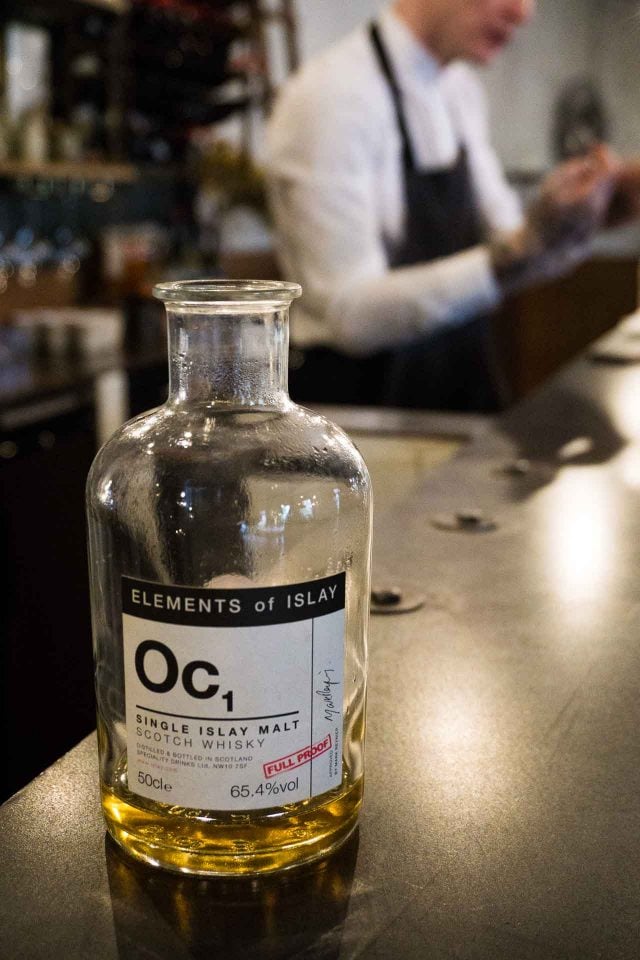

It was grey and rainy most of the time we were there, which didn’t bother me. I’m from San Francisco, and live in Paris, so I rarely pay attention to the weather. I’m also one of those people who are used to it, and doesn’t mind the rain. So I fit right in.
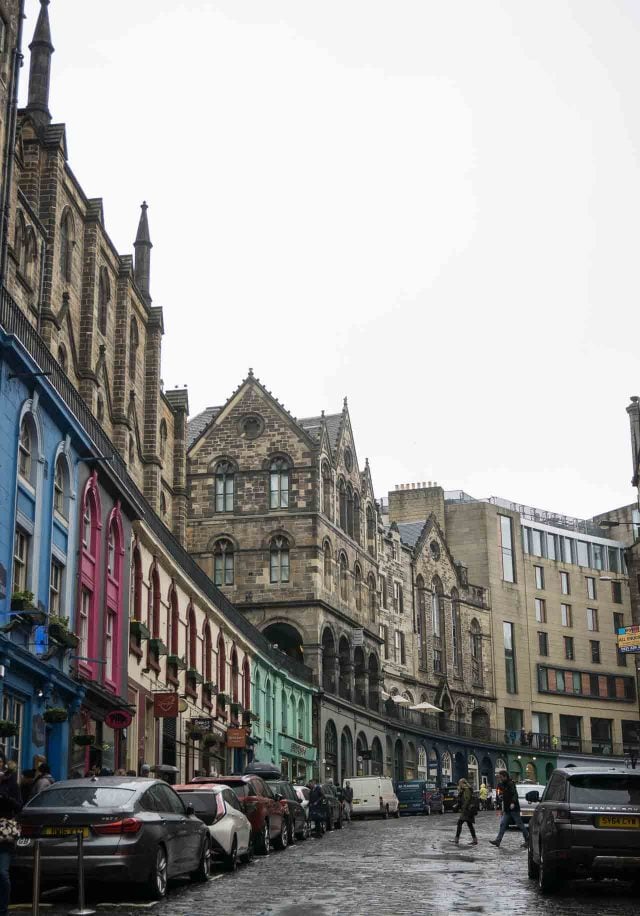
Due to flight schedules, once they tucked the kids into bed, our first night we dined late at Le Roi Fou, which was a little posher than I’d imagined. Swiss-French Chef Jérôme Henry is known for using local products in his modern cooking, that doesn’t veer too far from tradition.

We started off with an outstanding platter of Loch Fyne Scottish oysters, and then a bowl of hand-harvested scallops. Jérôme Henry’s mastery of classical techniques was evident in the excellent fennel-saffron sauce that was pooled under the exceptionally fresh scallops, which we all agreed were excellent. Two in our group ordered the Isle of Gigha halibut with capers and brown shrimp, which could have been taken off the heat a little earlier, but we ended the meal with a lively lemon sorbet topped with candied bergamot and a shot of local gin to douse our tangy scoops. Or drink separately.
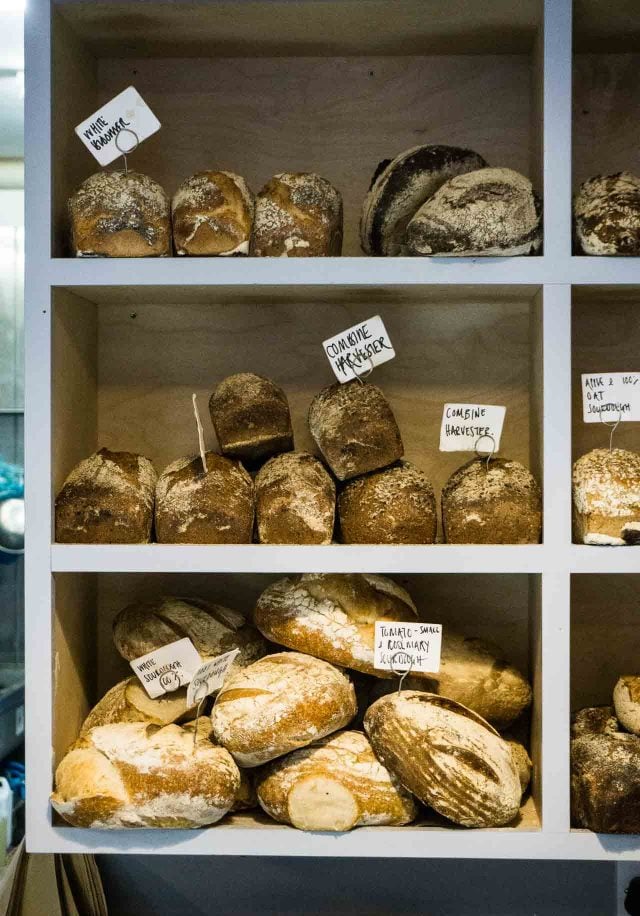
The next morning we stopped at Archipelago Bakery and I immediately honed in on the flapjack.

A local said, “Oh, those are very rich…lots of butter!” which I wasn’t so sure of. I mean, a flapjack is a relative of the granola bar, which are usually packed with dried fruits, grains, and oats. (Which I’ve never been able to master.) Then I looked at some recipes and found out she was right. Most recipes didn’t skimp on the butter. Fortunately, Edinburgh is a hilly city, so we worked off (most) of the flapjacks while we were there.
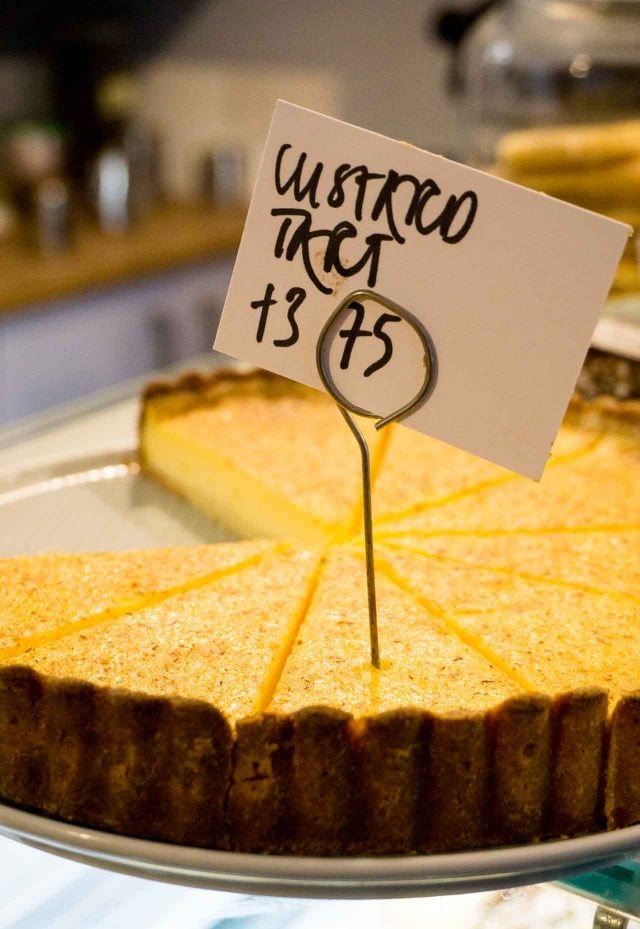

After the bakery we met up with Nikki Welch, who co-authored The Pocket Guide to Whisky, a handy, easy-to-reference guide to the world of Scotch whisky. (Like in Canada, whisky in Scotland is spelled without an “e,” which is driving my spell-check bonkers.) In her tour, we focused on pairing Scotch whisky with local and Scottish specialties. She arrived armed with six bottles of Scotch, which she valiantly toted around town with us.
(It’s also helpful to have some local assistance with the whisky, as some of the names are quite a mouthful; Bunnahabhain, Craigellachie, Tamnavulin, Tullibardine, etc…)

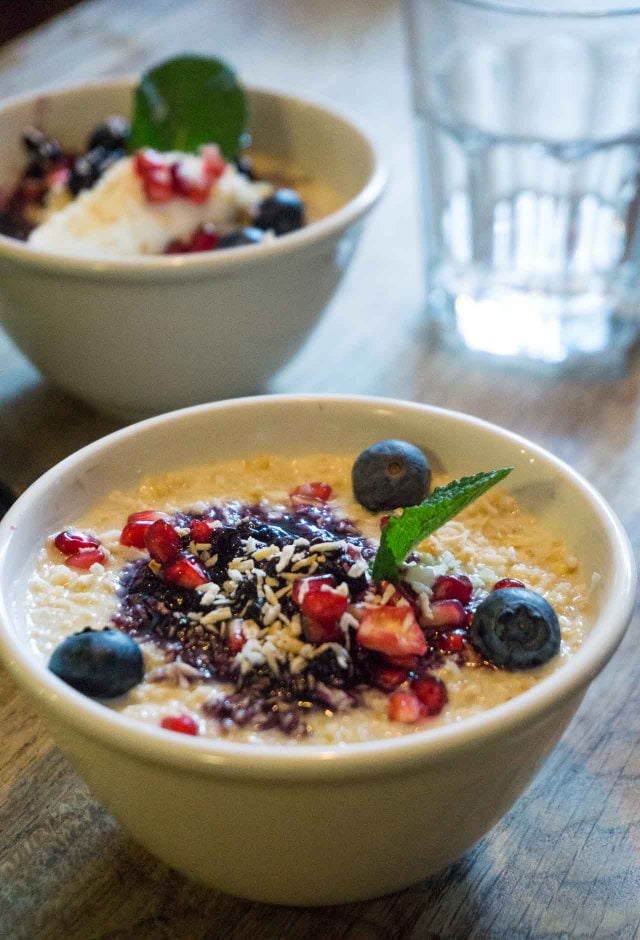
Our first stop was The Pantry for some porridge – and Scotch – at 9:45 am. This friendly little cafe offers up simple but hearty food, the kind you want/need to eat in the morning before a morning of tasting Scotch (and chocolate, cheese, cakes, and fish & chips), along with a selection of house-made cakes, croissants, and local breads, which were being delivered as I tried to explain ‘porridge’ to Romain, which doesn’t quite translate. In fact, the French just call it porridge as well. A few porridge bars and cafés serve bowls of it in Paris, but I don’t think many eat it for breakfast. And I’m certain they don’t accompany it with a belt of Scotch, like we did.
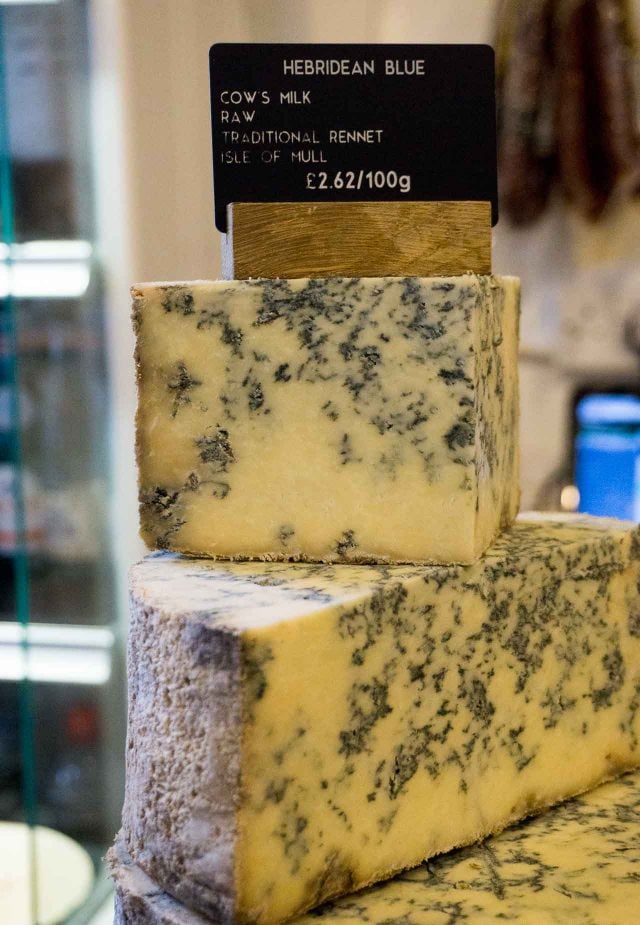
But the French are no strangers to cheese and cheese is almost as popular in Scotland as it is in France, as evidenced by the crowds at I. J. Mellis, a terrific shop that specializes in farmhouse and artisan Scottish cheeses, and makes a mean grilled cheese sandwich, to boot.


Of course, we had to try them with Scotch, which I have to say, is just as good as wine with cheese. Two of my favorite whiskies were the 16-year-old Lagavulin and Talisker. I also liked the Scapa, which is produced in the Orkney Islands on the Northeast coast of Scotland, and I could swear I tasted a bit of the salty sea breezes in the glass.

Scotch whisky is produced from barley, which is dried over a low fire. If peat is added to the fire, the whisky is “peated.” (The word is tourbé, in French.) The very tough pieces of decomposed peat give the barley a smoky flavor. Not all Scotch whisky is peated; some like it, some don’t.
It’s a matter of preference and while it doesn’t usually say it on the bottle, a good spirits merchant should be able to give you some idea of how heavily peated the Scotch is when you’re buying it. In Scotland, you don’t need to ask as I found they’re usually more than happy to give you a taste. At the airport, they had about thirty bottles of Scotch open for tasting, and almost forced me to work my way through them. (Hence the three bottles I bought. One bottle was a full liter of Scotch, which the clerk was especially excited about. So I had to buy that one as I didn’t want to disappoint her.)

Scotch can be pretty high proof – a few we tasted were 65% alcohol, or 130 proof. (A standard bottle of whiskey, vodka or gin is usually 80 proof.) To properly taste it, sometimes a little water is added to dilute the alcohol, which brings the flavors forward. A little pitcher of water may be on the bar, or brought to the table. Ice is acceptable as well. The only thing I was told wasn’t acceptable to add to Scotch was Coca-Cola, which they didn’t have to worry about with me.
While it’s not added to Scotch, cheese is a perfect pairing for the spirit, especially a Somerset cheddar or Stilton. It’s just as good as wine, if not better because you don’t have all those tannins (especially with red wine) to compete with the cheese. It’s all personal preference, of course, but if you have a bottle of Scotch whisky on hand, next time you’re serving cheese – or grilled cheese sandwiches, try pouring a few sips of Scotch. With three bottles that made it back to Paris with me, future guests will be treated to a little Scotch tourbé with their fromage.
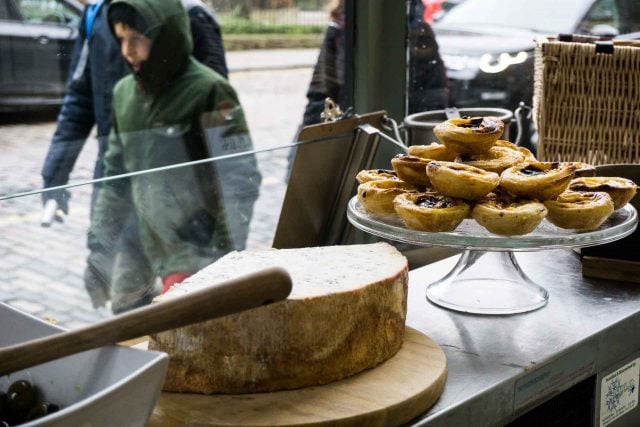
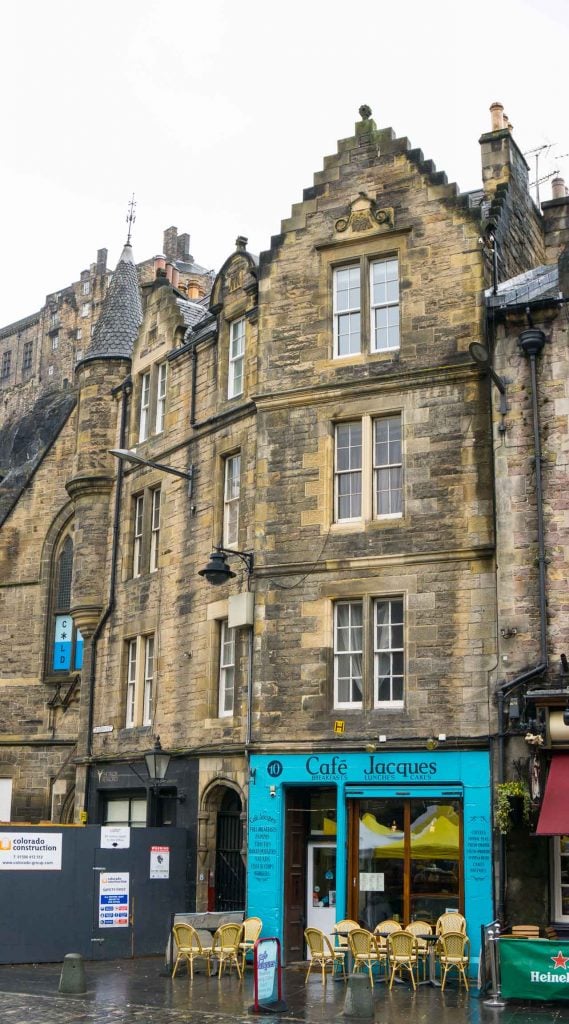
And yup, Scotch goes with chocolate, too, which we found out at Coco Chocolatier.
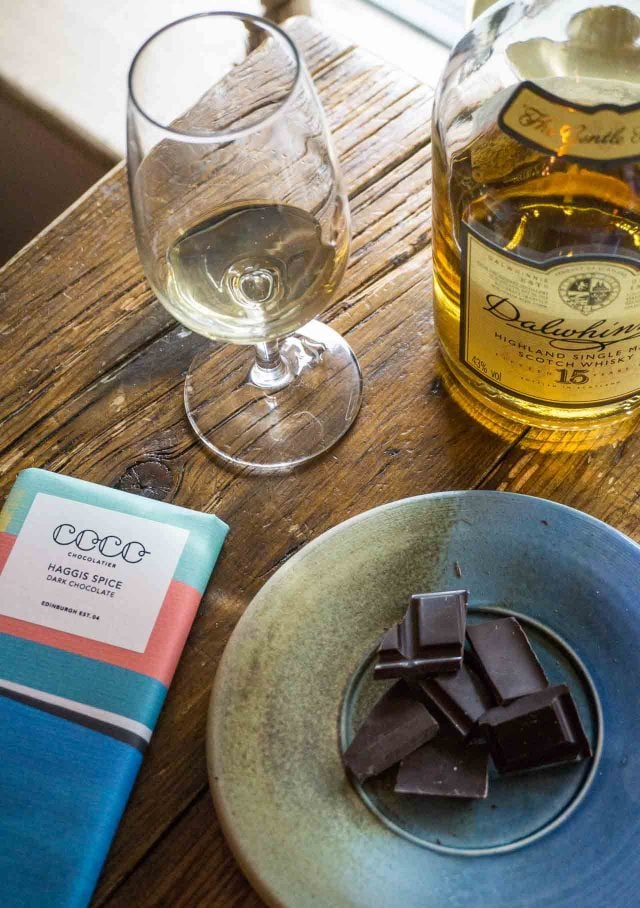
Coco blends Scottish flavors into their bars of dark and milk chocolate.
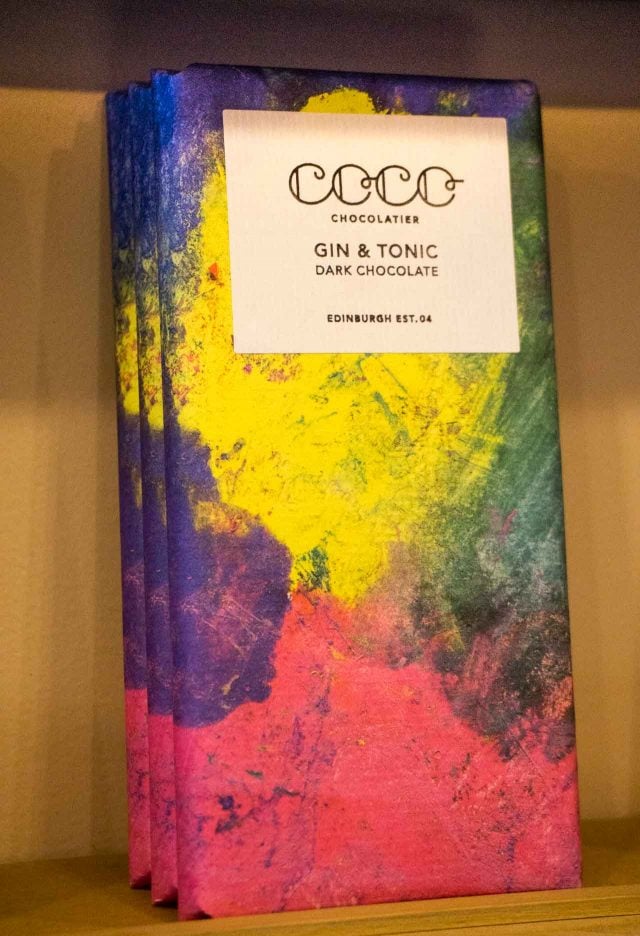
Haggis chocolate piqued our curiosity, which, fortunately, was flavored with haggis spices, not the mix of innards that is a challenge for some (…or most?) visitors. The rest of us were happy that the bar of chocolate just had the spices, Romain eats andouillette, so he’d probably be up for it. It’s one of those things you have to be born French to appreciate. The Wikipedia page said it has a “strong, distinct odour”…which is underestimating it.
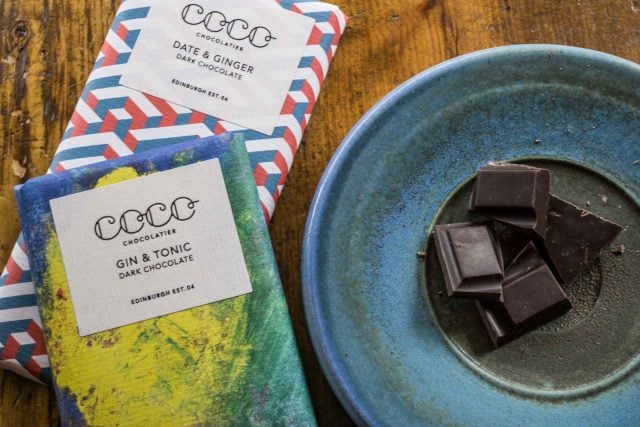
We did like the Haggis-spiced chocolate with the Scotch. The mix of black pepper, allspice, nutmeg and cloves went well with the slightly smoky sips. My favorite chocolate at the shop was the bar flavored with caramel, hazelnut, and Isle of Skye sea salt, although the gin & tonic was the one was we were most eager to experience, flavored with juniper oil, as well as lemon and lime. We didn’t have any on hand, but I should have brought a bar home to pair with some gin.

The following day, I spent the morning with Charlotte Maberly, who created the gastronomy program at Queen Margaret University in Edinburgh. Scotland, of course, has excellent products, such as Scotch whisky, fish, cheese, meat, and butter, but like other places, people sometimes forget that they can buy vegetables and fruits (when in season) locally.
While we shopped the Edinburgh Farmers’ Market, a compact market by Edinburgh Castle, we talked about the U.S. and France and how people shop, as well as what’s changed over the years, and what’s available.
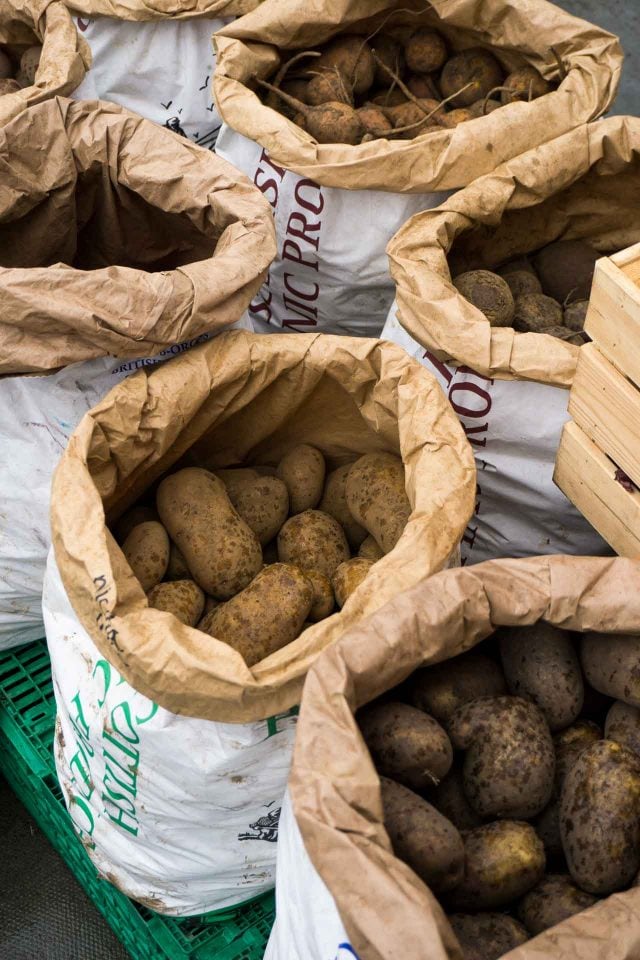
The produce at the market in April was heavy on the potatoes and root vegetables, which is to be expected, considering the climate and weather.

When I posted a picture on social media, a few pointed out that avocados and tomatoes weren’t likely local. I, too, am guilty as charged, and often buy avocados, rhubarb, tangerines, and oranges (but not tomatoes) that aren’t local. I miss the abundant citrus we had in California but I don’t live in a climate where most of those things are grown, so have to resort to picking up those things at market stands that aren’t producteurs (growers).
Also, it’s helpful to realize that not everyone, or every culture, is at the same place. Scotland has wonderful local ingredients, but like most other countries, as Charlotte pointed out, getting people to change their habits and shop at farmers’ markets can be a challenge and often it’s a gradual shift.


Edinburgh isn’t California, and even people in New York City (which has fifty greenmarkets and are very strict about how far away produce and other items can come from ), people will still shop at the supermarket when they need limes for their gin and tonics. In fact, this morning I’m going to the supermarket to get yeast, because I don’t know anyone around here who cultivates their own yeast ; )
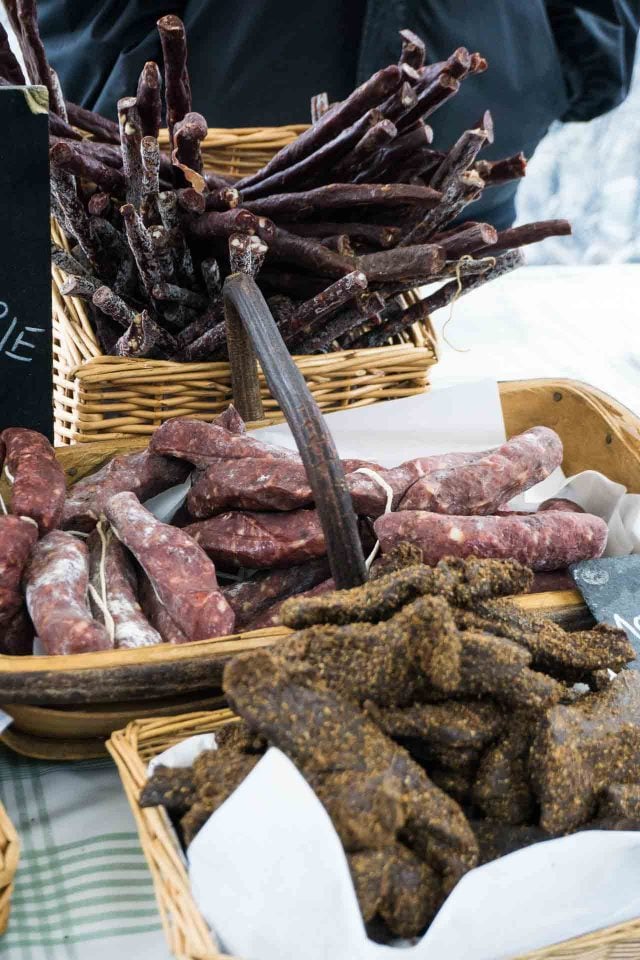

What the Edinburgh Farmer’s Market really specializes in is seafood and meat, smoked and fresh. Very fresh, as in, these langoustines were still crawling.

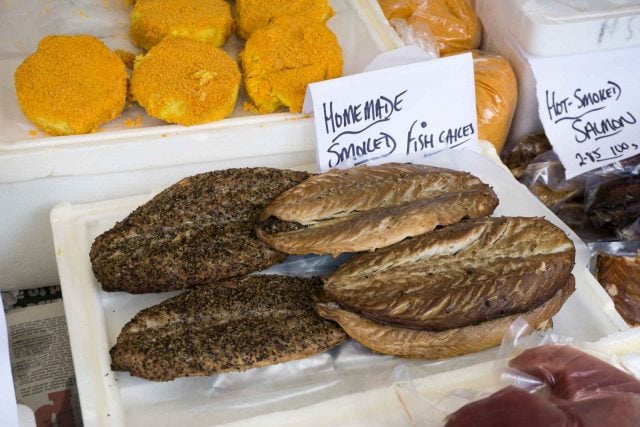
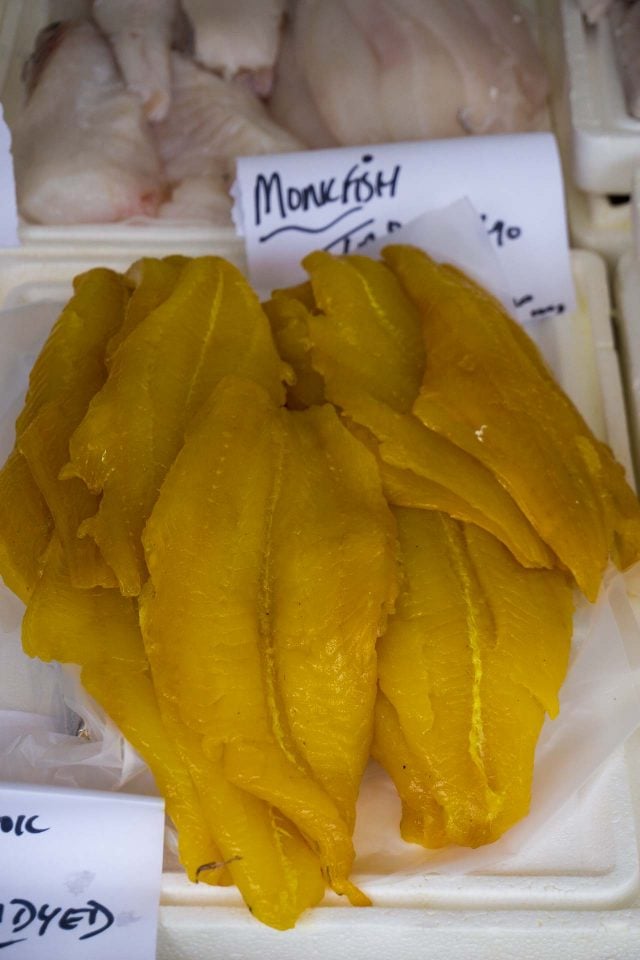
There was some lovely fresh (local) fish, but what really got me excited was the smoked fish. The selection was amazing. I was traveling light (carry-on only) but made sure that I had room to bring a few things back. When I reached for a package of black pepper-smoked mackerel at Skipness Smokehouse stand, Charlotte said “Oh. Aren’t you going to get the one without black pepper, so you can taste the mackerel better?”
Uh…I hadn’t thought of that. Tempted to put it back and reach for one without black pepper, I decided to get both, and was glad I did. When I got home and tasted the black pepper-smoked mackerel, it’s was incredible. No doubt the best smoked mackerel I’ve ever had in my life. I can’t wait to open the one without pepper. Can’t imagine it being any better.
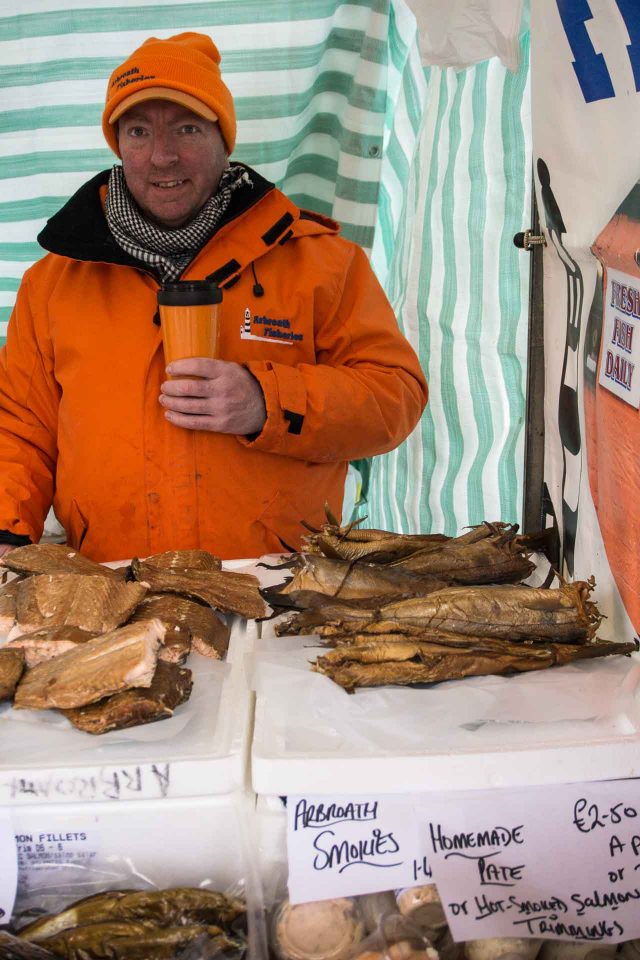
I’m also glad I tasted, and brought home (in spite of the lad at the airport who inquired about the “smoky-smelling black bag in my luggage,” who understood when I told him it was smoked fish, and let me go on my way), a few Arbroath Smokies, which I’m sure he would have approved of…if I could have remembered their name when we spent a few minutes talking about smoked fish. They’re worth having to fumigate my carry-on for after hauling all that smoked fish home.



The Scotts are no strangers to fermentation and to counteract the Scotch whisky-flavored candies we gobbled down at the Paper & Jam booth, (the picture above is of the non-Scotch infused ones, since they were for the kids), Lani and I did shots of kimchi kvass, fermented kimchi juice from the Edinburgh Fermentarium, that was delicious – and revitalizing.

We needed to be revitalized before we hit Pinnies and Poppy Seeds, a bakery that specializes in Scottish shortbread. Using Mungoswell’s organic flour that’s milled 15 miles away, and Graham’s Family butter, these saucer-sized shortbreads are big, and rich. One local told me they eat one every day, which I might file under “life goals.”
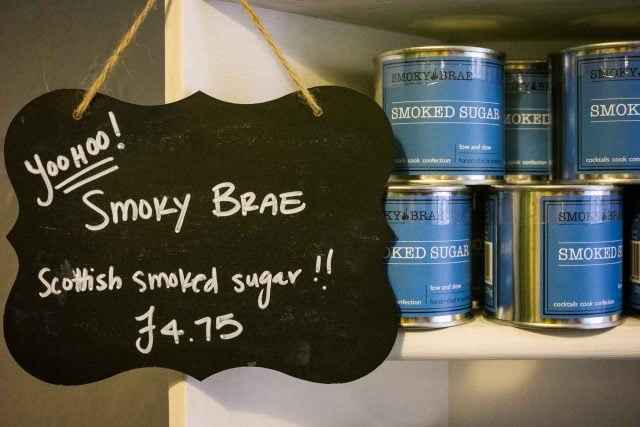
One curiosity on their shelves in the shortbread shop (and when I say “shop,” it’s a single counter with a kitchen, an oven, and a couple of bakers behind it), were tins of smoked sugar. On one hand, I didn’t know what I’d do with it. But on the other hand, how could I not get it?

[Stay tuned for part 2 of Edinburgh Eating, Drinking, and Dining, which I’ll be posting shortly.]
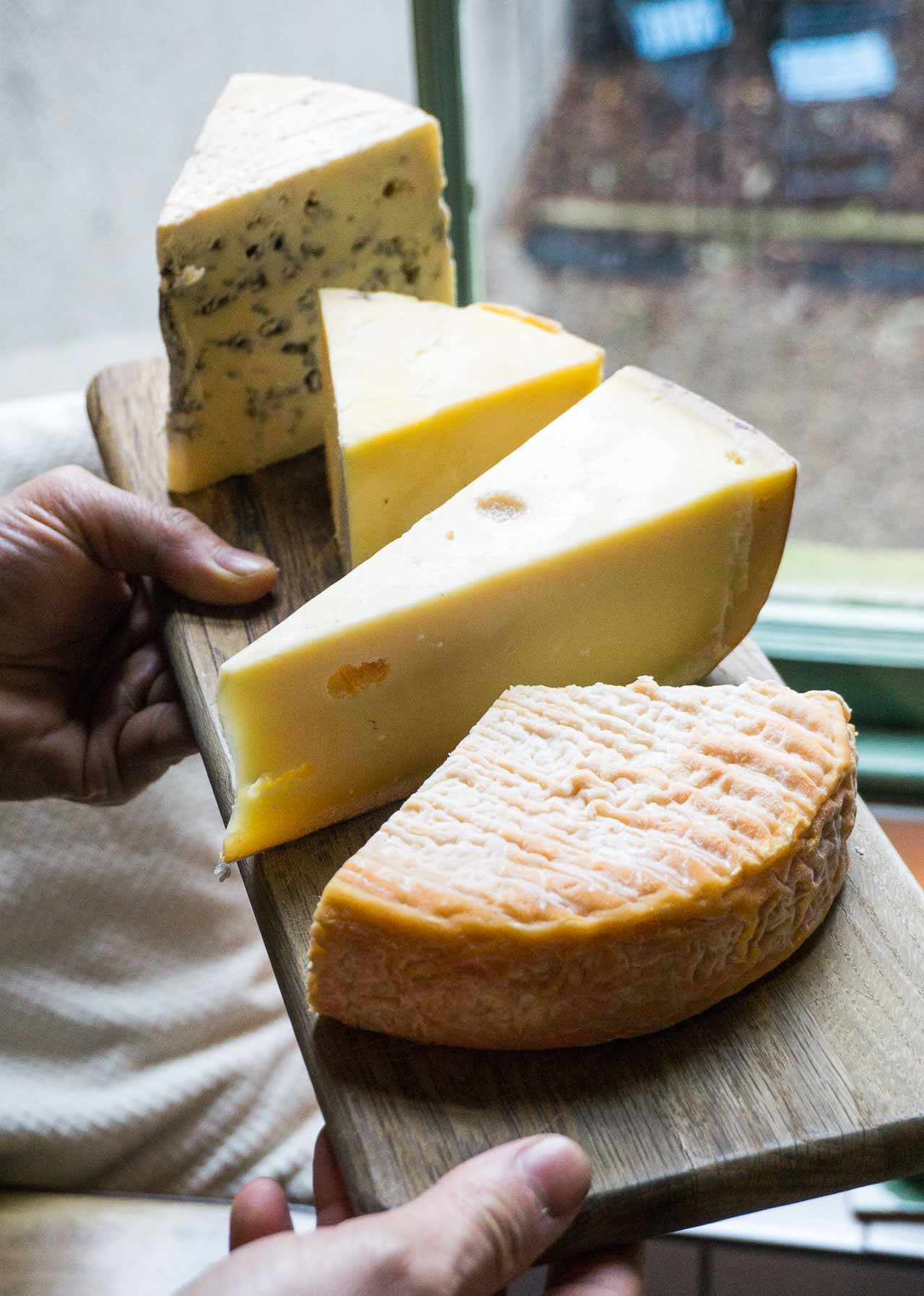

0 comments